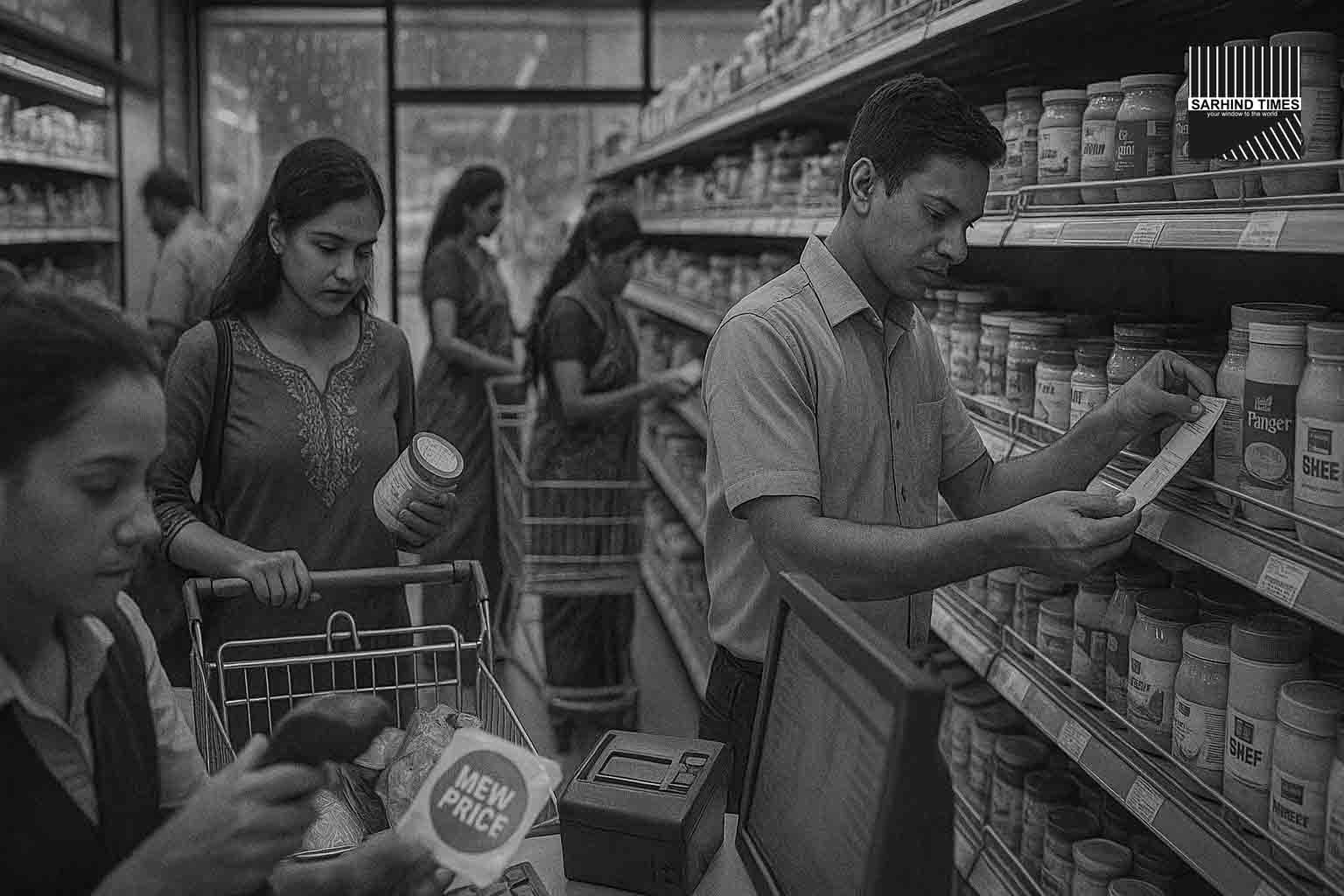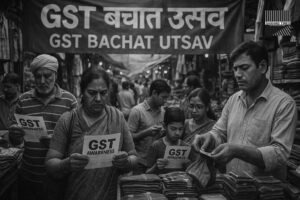Kerala’s Finance Minister K.N. Balagopal has warned of a “drastic fall” in state revenue after India’s new GST 2.0 regime—anchored around two slabs, 5% and 18% with a 40% rate for sin/luxury goods—took effect this week. Even as dairy exemptions and lower rates nudged shelf prices down (state cooperative Milma has already cut MRPs on ~100 SKUs including ghee and paneer), the minister says pass-through could be uneven and the fiscal hole for states deep, necessitating safeguards to protect salaries, social pensions, and capital spending.
What Changed Under GST 2.0—and Why It Matters for States
The Centre’s GST 2.0 rationalisation reduces the formerly four primary slabs (5%, 12%, 18%, 28%) to two core slabs—5% and 18%. Items deemed luxury/sin are placed at 40% to preserve buoyancy. The policy intent: simplify compliance, lower effective prices on mass-consumption goods, and spur demand into the festive quarter.
Early communication from government and business media outlines cheaper categories (essentials, many durables such as TVs/ACs now at 18%), while expensive categories consolidate at 40% to balance revenue. The expectation is that volume gains and broader formalisation will offset rate cuts—but timing, compliance, and sectoral asymmetries will decide how this plays out state-by-state.
Kerala’s Red Flag: The Revenue Math
Balagopal’s caution comes with ranges rather than a single estimate, reflecting uncertainty. Public remarks in recent days cite an annual loss of ₹8,000–₹10,000 crore for Kerala alone, alongside broader claims that all states combined could face up to ₹2 lakh crore in revenue pressures from the rejig, pending the strength of volume growth and anti-profiteering enforcement. Kerala’s dependence on GST (≈41% of income) heightens exposure to any shortfall.
Key concerns from Kerala:
- Base erosion risk: If lower rates don’t translate into sufficiently higher volumes, net GST collection dips.
- Uneven pass-through: Companies may delay or dilute price cuts; the Centre itself has acknowledged pass-through concerns historically.
- Cash-flow fragility: Kerala’s committed spends (salaries, pensions, social schemes) leave less room to absorb volatility.
Dairy Exemptions: Quick Relief at the Shelf, Uneven Uptake in the Aisle
Food-side relief has been immediate and visible in Kerala. Milma announced reductions on roughly 100 products—from ghee and paneer to butter, flavoured milk, and payasam mixes—as GST dropped (e.g., flavoured milk: 12% → 5%; UHT milk: 5% → 0%; payasam mix: 18% → 5%). This is the policy win consumers see first.
But Kiranas vs. supermarkets are adjusting at different speeds. Chains can re-label and re-price overnight, while small stores often sit on pre-GST-priced inventory, passing on cuts only after replenishment. Expect 1–2 weeks of friction in neighbourhood markets, which can blur the optics of reform for everyday shoppers.
Anti-Profiteering & Compliance: The Tricky Middle
For GST 2.0 to raise real incomes, consumers must see and trust the cuts at the shelf and on the invoice. Kerala’s line is clear: strict monitoring is needed to ensure rate benefits aren’t absorbed into margins. Practical levers include:
- Invoice transparency at the POS, with old vs new MRP comparisons during the transition.
- Helplines/portals for customers to flag non-compliance and swift inspections in outlier clusters.
- Public dashboards tracking repricing timelines for top FMCG/dairy categories.
These steps, while operationally tedious, can amplify the demand stimulus and build confidence.
The State-Centre Compact: What Safety Nets Could Look Like
If GST rationalisation is a national public good, then transitional pain should be shared. Policy options on the table (some used in earlier GST phases):
- Time-bound compensation window: A calibrated scheme to smooth revenue volatility, conditional on reforms (e.g., e-invoice coverage, analytics adoption).
- Advance releases of devolution/central grants to states with higher GST dependency or weaker own-tax buffers.
- Counter-cyclical borrowing room: Temporary relaxation in deficit targets with credible glide paths back to FRBM norms.
- Rebate-for-reform: Incentivise states to hit compliance KPIs (e-way bill–invoice matching, AI-based risk scoring) in exchange for targeted fiscal support.
Kerala’s case underscores why data-backed, time-limited cushions can help states adjust without slashing capex or welfare.
Will Lower Rates Pay for Themselves? The Elasticity Question
The Centre’s bet is classic: cut rates, grow the base. For this to work, three forces must align:
- Price elasticity of demand in discounted categories (dairy, essentials, entry-level durables).
- Supply-chain responsiveness—can producers and retailers scale volumes without bottlenecks?
- Compliance/anti-leakage—can improved tech and analytics plug evasion enough to protect buoyancy?
Early national coverage highlights strong consumer-facing narratives—“Food, TVs, ACs become cheaper”—which can kick-start volumes into Navratri–Diwali. But elasticity varies: dairy is high-frequency, low-ticket; durables are big-ticket, deferred. Expect quicker, broader uplift in FMCG/dairy; more staggered in durables as inventories and financing offers rotate.
Kerala’s Structural Constraints (and Why They Matter Now)
Kerala’s fiscal architecture features:
- High social-sector commitments—pensions, welfare, health.
- Remittance-linked consumption—sensitive to global employment cycles.
- Narrow industrial base—less room to rapidly replace tax losses with boom sectors.
In a two-slab world, rate dispersion narrows, reducing arbitrage but also compressing room to tailor sectoral incentives. That’s why Balagopal’s call for “proper studies before sweeping changes” resonates—Kerala wants clear modelling on net-net impacts by sector and income cohort.
What To Watch (Next 4–8 Weeks)
- Shelf-price audits in Kerala across dairy and FMCG baskets (Milma vs private labels).
- POS data from chains vs kiranas—speed of repricing and sell-through.
- GST e-way bill/e-invoice trends—does reported turnover rise YoY vs. pre-festive 2024?
- State cash-flow indicators—any payment delays (pensions, supplier bills) or capex rescheduling flagged by Finance Dept.
- Centre–states dialogue—movement on compensation frameworks or targeted grants.
Consumer Lens: How Households Can Actually Save
- Seek revised MRPs and retain invoices—they’re your leverage if pass-through lags.
- Compare SKUs across formats (cooperative brands vs private labels) during transition weeks.
- Use official lists/FAQs (when available) to know category-wise rate changes—very useful in disputes at the counter.
Retailer/SME Lens: How to Navigate Without Margin Shock
- Batch-wise re-labelling with clear old/new MRP logs.
- Explainers at the cash counter: a one-pager on GST 2.0 items you’ve already repriced vs. those pending stock rotation.
- Invoice transparency: line-item tax display builds trust and reduces conflict.
- Claim input credits properly to avoid cash-flow crunch in the changeover month.
Bottom Line
GST 2.0 is a bold simplification with clear consumer-facing wins in Kerala’s grocery aisles today. But the state treasury’s spreadsheet tells a tougher story: if pass-through is partial and elasticity underwhelms, revenues fall faster than volumes rise. Kerala’s warning isn’t a rejection of reform; it’s a call for guardrails and data transparency so that rate cuts don’t become unfunded mandates for the states carrying India’s welfare and development agenda.
#Kerala #GST #GST2_0 #StateFinances #TaxPolicy #Consumers #Dairy #Milma #Economy #Inflation

























+ There are no comments
Add yours